

Sponsored by Peter Vaughan,
East Anglian Cyclemotor Club
Devon member
Thursday evening at Foxhall Stadium, Ipswich, and the crowds are flooding in. Floodlights illuminate the oval stage, the tape drops, a thrilling roar of mighty engines as the spinning rear wheels throw out a plume of cinders in their wake. Four riders bank into the first bend and power through the turn with their bikes at a jaunty angle, wrestling the bars to point the wheel down the track. A deafening blast as the bikes hammer by on the back straight, while the scent of Castrol R hangs heavily in the air.
Captain Louis cruises round his lap of honour, arm aloft - Ipswich Witches win again!
This was speedway racing at its zenith in the early '70s, at which time Peter Cornish was living in Bradfield St George and running Mustang Tools in partnership with Jeremy Woodhouse. The Woodhouse-Cornish duo initially came together as Woodhouse had a plastering business, and Peter Cornish developed a cutter for him to do some tile work. They started making the tile cutters together, registered a patent, and selling them to builders' merchants as Mustang Tools. The range of equipment progressively extended to fencing tools, then design, development, patent and manufacture of a specialist pipe cutter that was subsequently taken up by Hepworth Building Products of Sheffield.
Our interest in this business joins at the point where Peter Cornish purchases five Anker Laura motors out of Exchange & Mart in 1973, and within a week has created a garden/track bike for use by his sons Nick (7) and Mark (9). The frame was built using square box section tube, including the petrol tank formed between gusset plates welded into the frame headstock, mounted 1" diameter rigid tubular forks, and ran on Raleigh Wisp wheels.
From its appearance in July 1970, these Anker Laura moped engines were coming as leftovers from BSA's Ariel 3 debacle, the market being flooded with surplus parts once the infernal granny-killer tricycle was abandoned. Though the Ariel 3 was officially de-listed in December 1974 when the last of the stocks finally became cleared, the project was written off somewhat before this time when BSA realised their marketing vision of future mopeding would not be riding on 3-wheels. We're not quite sure of the formal cancellation date of the Ariel 3, but Euro-Equipment Supplies were certainly advertising 'surplus' Anker Laura engines in Model Engineer as early as 1st June 1973.
Adapting the Ariel 3 Anker engine for application in the bike involved machining the toothed belt pinion on the clutch drum down to a locational boss, and welding on a 12T Mobylette front sprocket to convert to primary chain drive, then covering the dangerous whirling bits by a fabricated steel chaincase. With the intermediate sprocket shaft located from a fixed-point boss welded to the frame, the primary chain is tensioned from the engine mountings, and final drive chain by conventional cam adjusters at the rear wheel.

Paul Hunt riding the very first SIM
Painted red, this prototype had a low mounted carburettor out the left hand side, proving a less than ideal location since the air filter, adjacent to the footpeg, was vulnerable to being knocked off. Also recognisable by the half-width hub Wisp front wheel, Paul Hunt is pictured riding this very first SIM, since it wasn't long before a number of youngsters about Bradfield became micro-bike riders around their back gardens, or in sunny summer holidays, where 20-30 kids would queue patiently for their turn on the bike for laps around the village green.
With neighbouring youngsters showing much interest in the mini-cycle, enquiries came in from other parents for further machines, so another four bikes were built around the remaining engines and all sold locally. Their carburettors were now relocated above the engine on a U-form manifold, fabricated from the same square section tube that made the frame.
It was becoming apparent that this little garden bike had some potential, and Woodhouse Cornish were considering the prospect of larger manufacture.
At this time, many ex-trade motorcycle parts were being advertised for clearance through Motorcycle News, by Harris of Watery Lane, Birmingham, including considerable stocks of surplus new Anker Laura engines. Peter Cornish purchased their first batch of 500 engines at just £3 each, along with quantities of hubs, sprockets, spokes, and 2×12" Dunlop 36 hole back rims (surplus Raleigh Wisp), tyres, tubes, cables, brake levers, and throttle twistgrips, all bought in job lots by the pallet load.
Production commenced at Bradfield St George with the building of around 100 machines to the original (Mk1) square-tube frame design with rigid fork, and badged by a simple black & white SIM50 logo on an oval decal. These early machines were further characterised by matching full width alloy hubs front and rear, built up from rear hubs laced into 36 hole rims with a 44T sprocket fitted at the back, and individual exhaust arrangements as the concept developed.
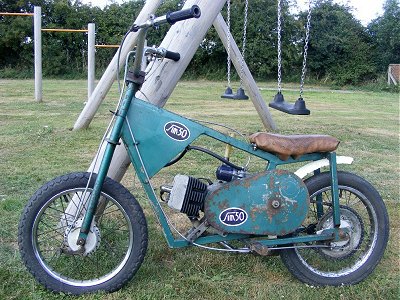
Mark I SIM
Having no kickstart or pedals prescribes push starting as the most suitable method for our Mk1 SIM. Fuel on, but there's no choke mechanism fitted on this Encarwi 12mm carb, so we need to put a left-hand thumb over the air intake tube just ahead of the seat, while decompressing on the twistgrip with the other hand. With the motor being ratchet driven as the bike moves forward, weight needs to be placed on the frame to prevent the wheel skidding, so sit on saddle and 'paddle' away, then turn on the throttle to fire up the engine, which starts pretty easily so you can readily take your hand away from its intake tube. The motor gives out an aggressive crackle through its straight-through exhaust, and after warming the engine, the automatic clutch keenly snatches as the throttle is opened. Torque afforded by Anker's reed-valve induction strongly overcomes the snappy drive engagement, and offers useful acceleration without lots of dramatic revving or clutch slipping. Followed by the pace bike, we burn up the track to top out at 27mph with a loud droning racket blaring from the unsilenced pipe.
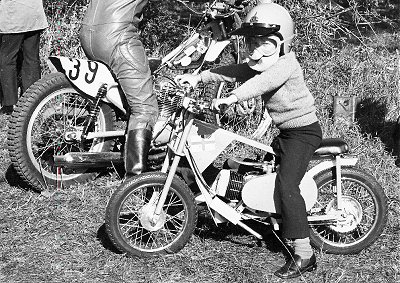
Nick Cornish posing on
an early SIM50 at Bradfield Green
Typed letters dated 1st October 1974 were prepared for sending out to regional agents, but at this stage the project was developing appreciably faster than the paperwork could keep up. Before these letters were sent out only some three weeks later, amendments had been made. Given with a Recommended Retail Price of £99.36, the trade price had been adjusted to £73.60 +vat, and the Woodhouse Cornish telephone number was crossed over, with John Louis Racing 67912 underwritten. A black & white photograph of young Nick Cornish posing on another early SIM50 at Bradfield Green accompanied these letters, and in the background is seen a Honda CB125 powered speedway/grasstrack bike, which was also produced by Cornish and marketed as a Camel frame kit, for people to build up with their own engines.
Though the Ipswich Witches speedway captain had been commissioned to endorse the SIM50 for the forthcoming advertising campaign, he played no further practical involvement with the project, and all future trade contact references returned to Sicklesmere 400.
Mentioned in the trade letter, the first press of coloured promotional leaflets feature a cover picture of John Louis with Nick Cornish on a new SIM50 development model, and text above the logo at top right tells us for the first time that the title translates as: Speedway In Miniature.

First (upper left) and second (lower right) versions of the SIM50
leaflet
The first batch of leaflets are identifiable by the white crash helmet (that rather appears to have been graphically added to the photograph), while the later reprint batch features a red crash hat (presumably to further emphasise the safety suggestion?)
With the establishment of initial orders, the original square tube, welded assembly frame was succeeded by a ¾" diameter tubular loop design, more suited to volume build as production relocated to a larger unit at Station Hill, Bury St Edmunds.
The frame was now mounting own-make telescopic forks, and a fabricated steel petrol tank with SIM50 badges on a union flag background. Instead of mounting a front mudguard, a speedway-style alloy stone guard bolted to brackets on the frame downtube.
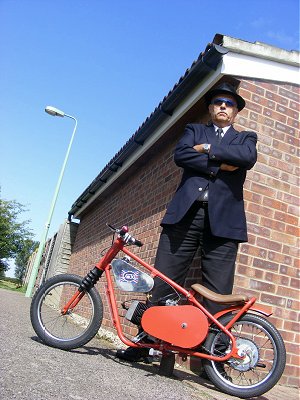
"Despite only standing to
knee height against an adult..."
The presence of a front brake became deemed unnecessary and discarded during the transition, to be replaced by a plain cycle hub. Arguably in the spirit of speedway bikes having no front brake, this decision may also have been influenced by the further purchase from Harris of a large batch of cheap 28 spoke cycle wheels built with 16×1.75 MW Italian rims.
The straight pipe exhaust of the illustrated brochure subsequently received the addition of a silencer barrel, and an alloy plate was included on the right side to further shield the reduction drive for production models.
Since the SIM bikes were never intended for road use, none were ever formally identified by any frame serialisation. It therefore seems most logical to qualify the sequence of models by their different frames, so for purpose of identification, this model is defined as the Mk2.
The trade introductory letter describes the SIM50 as a "small speedway motorbike designed for children between 5 and 10 years old, and strong enough for an adult to ride". Despite only standing to knee height against an adult, this tiny bike certainly was substantially constructed, with the main forks comprising 1" diameter × 1/8" section tubular legs welded into steel yokes flamecut from ¼" gauge plate. No ball race sets in the SIM steering head either, which reflected speedway practice to pivot on phosphor bronze shouldered plain bushes.
Television features appeared on the BBC Look East and ITV's About Anglia programmes, an entry found its way into the On Two Wheels magazine, and Motor Cycle News included a 2-page feature.
Though dealer interest in the SIM50 was quite encouraging, this really only represented a minor sideline of the company's main business, which was making significant quantities of building trade equipment at this time, such as brick lifters, brick profiles, paving slab cutters, and ceramic pipe cutters.

"SIM50 advert featuring John Louis
Sales shortly went national as SIM promotions began appearing in the motorcycling press, and during the run up toward the festive season, "Order now for Christmas" advertisements appearing in Motor Cycle News, carried a 'Footnote to the trade: owing to the heavy demand for SIM50, we need more notice on orders'. Re-costing the new the Mk2 had also now increased the RRP to £120 + VAT.
As a typical example of parents across the country, speedway fan Errol Bristow purchased a new Mk2 SIM from Andy Lee Motorcycles of Cambridge, as a late birthday present for his son to ride. He still has the bike, and the original invoice dated 15th May 1976, showing a price already increased to £132.26p, which starkly illustrates these inflationary times!
As the scene of youngsters riding Nigel Bristow's new toy around Watton Village Green in Norfolk came to reflect the activity at Bradfield, other customers included the famous store of Harrods at Knightsbridge, where Peter Cornish recalled personally delivering five machines - all purchased to go to the Middle East, while stunt rider Eddie Kidd was also reported to have had a SIM50 as his first bike!
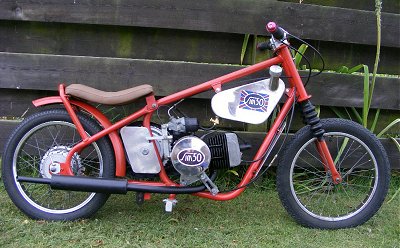
Mark 2 SIM50
Starting our Mk2, simply turn on the fuel, raise choke lever below the seat at the right hand side, twist the throttle grip ahead to decompress, with one knee on the seat to put weight on the frame and prevent the real wheel skidding, scoot down the drive, turn on the throttle and the automatic clutch takes over the moment it fires. For smaller youngsters, it's just as easy to 'paddle' the bike off - they quickly get the hang of the starting procedure.
The exhaust gives out a pleasant flat burbling tone as we warm the motor and switch off the choke. Initial acceleration on this Mk2 might be slightly stunted by the fitment of a Dural 38T rear sprocket that became installed to spoke-wheel versions of this model once stocks of the 44T sprockets ran out, though expectation of any higher top speed proves limited as the motor enters a rage of four-stroking at 25mph (not an unfamiliar effect to many Ariel 3 riders).
As the first batch of 500 engines began to run down, a second lot of 1,000 motors was purchased from Harris to continue production. SIM bikes were typically built in batches to fit in between the commercial building equipment, generally employing a couple of fitters, and at peak assembly times they could reportedly have up to ten operators working on their manufacture.
With the ongoing production, features of the SIM continued to evolve, though there was no distinction between the introduction of specific changes to the Mk2. The machine simply developed as a series of modifications came through, so a number of bikes can be identified progressively incorporating the various phases.
Changes to the SIM were as often driven by supply of materials as engineering initiatives, not least among such situations being the running out of all suitable wheel component stock at Harris! To resolve the spoke-wheels crisis, new alloy wheels were sand-cast by neighbouring Haldo Developments of Bury St Edmunds, then finish-machined by Cornish themselves. While the front remained a brakeless wheel, the rear now sported SIM's own made 42T sprocket and disc, with the cable-operated calliper bought-in from Talon Eng. The cast aluminium wheels were smaller diameter than the preceding 12" Dunlop rims and, although fitting slightly fatter 2.50×10 tyres, the outside diameter was reduced from 16" to 15". This reduction in circumference technically dropped the final drive ratio by 6.5%, and was effectively compensated by two fewer teeth on the new rear sprocket (returning the ratio by 4.5%). This 2% ratio reduction to a sub-30mph bike represented barely ½mph, and was of little real consequence, since a SIM's top speed was of no significance under the conditions it would generally be used.
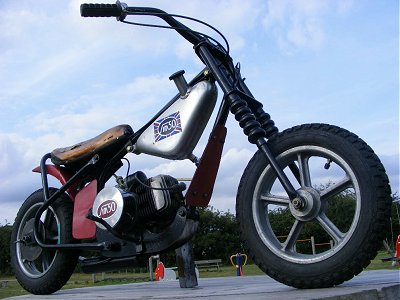
Mark 3 SIM50
It's often presumed that the later models utilised market standard alloy speedway tanks to further emulate the track bikes. Not so! These were actually uniquely produced for the SIM, as Peter Cornish invested a great deal of time in personally making a press tool to form their own petrol tank halves from aluminium sheet, which were then welded together with all fittings within the business.
Moulds were also created now to produce the chaincase and rear mudguard in fibreglass. Handlebar clamps changed from the earlier alloy block types machined as numbered pairs, to a steel fabricated assembly. The stone guard switched from alloy plate to steel sheet, as did the reduction drive shield, while the fabricated, square-tube inlet manifold became replaced by a curved form, round pipe.
By the time the last changes to the frame and footrest assembly were in place, replacing the bottom tubes and adjustment brackets by an engine plate arrangement, and a different exhaust system that ran its pipe down between the engine plates and beneath the frame; so much had altered that the SIM50 was a completely different bike and had effectively now entered its Mk3 form.
The choke is now a rotary motor cycle lever, tucked away on a frame plate beneath the saddle. Fuel on, decompress, and simply wheel the bike down the drive with the engine spinning, then just turn on the throttle and Anker's M-48 fires right up. Our easiest starting machine doesn't even need any weight on the saddle!
The motor warms to a deep and mellow burble from the exhaust, and produces a pleasantly silenced tone as we run down the track at 27mph.
The first SIMs powered by motors other than Anker Laura, were specials for speedway rider Olle Nygren, who supplied ten Sachs 50cc, 7-speed, foot change engines. Built for Junior Speedway in Sweden, these high revving sports machines demanded bigger, stronger frames than the standard version.
Impressed by these motors, a batch of 50 Sachs Automatic engines was purchased, and built into a completely new (Mk4) chassis to suit, the main frame formed from 1¼" tube, with ¾" loops for the secondary sections. Welded-in engine plates made up the lower section, and the headstock mounted with a rigid fork set in a seemingly regressive return to the original design, though with a longer yoke. The luxury of the padded seat on previous models was now succeeded by the Spartan minimalism of a bare steel pan welded across the sub-frame tubes - yes, the Mk4 was made for real men!
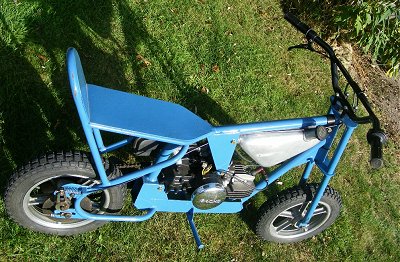
Mark 4 SIM50
It appears that the great majority (if not all) of these Sachs SIMs went to entertainment centres, 12 were delivered to the Kursaal Amusement Park at Southend, and a number more went to Charles Manning's at Felixstowe, where they replaced the decrepit go-carts that used to run around on the seafront circuit.
It was here that the author suffered a free ride around a wet and battered concrete track on one at the end of a summer season, but to be fair, the potholed condition of this surface was never going to be sympathetic to any rigid framed machine. Though the Sachs engine seemed to pull well enough when opened up, the vibrations rattled the loose petrol tank enough to drive any man to madness, while the bare metal pan caused the rider to slide off on corners, and imparted so much discomfort that it seemed a better option to stand up on the pegs instead! All the while being bombarded by loose stones on the track, and a fountain of spray thrown up from the mudguardless front wheel - just one lap was quite enough to form an opinion!
Perhaps the amusement park's idea was to ensure a constant turnover of punters by discouraging people being on the bikes too long, but that theory seemed to be working a little too efficiently! The service garage for the Seafront Ride was reportedly packed with SIM bikes, so it appears that most of the Mk4 production ended up here, and was the origin of our Mk4 feature machine after the ride closed.
So how much would we like to relive the Mk4 experience 30 years on?
Still requiring a push start, the Sachs engine in the Mk4 SIM is a slightly different operation. Fuel on, push down the choke rod on the Bing carb, with one knee on the seat pan putting weight on the frame to prevent the real wheel skidding, scoot down the drive and pull in the clutch lock lever under the left handlegrip. The engine fires up pretty much as soon as it spins, release the lock lever, allow the engine to warm, and the choke lifts off automatically as the throttle is opened.
Initial acceleration is quite enthusiastic, but soon breaks into a sharp crackle of four-stroking as the engine reaches its rev peak at a paced 22mph, on a 42T rear sprocket. Our private test strip is obviously smoother than the old go-cart track, so the ride didn't seem too bad despite the all-rigid frame.
The Mk4 was built at the same time as Mk3s were still being produced from the dwindling supply of Anker Laura motors. Peter Cornish reported that reliability of the Sachs Auto proved quite a disappointment, and felt that an increase in the sales price to cover the high purchase cost of these engines would render the SIM50 unviable, subsequently, no more Sachs engines were ordered.
Manufacture of SIM bikes effectively finished when the last stocks of Anker Laura engines ran out around 1986, by which time other imported miniature motor cycles had also appeared on the British market.

All four of our SIM50s
It's unclear how many SIM50s were actually built, since Peter Cornish reported that up to a couple of hundred Anker engines were broken up to supply enquiries after parts, so a final figure around some 1,300 completed machines might be considered a reasonable estimate.
As Jeremy Woodhouse retired and faded from the scene, the business continued as SC Engineering, relocating to larger premises at Rougham Industrial Estate, making manhole lifters for British Telecom, and securing orders to make massive thermal ovens.
Following the SIM50, Cornish also made some 20 trikes using 3½hp recoil-start, industrial engines, for off road/track use.
Now, in the 21st Century, it's pretty well accepted that there are all manner of powered pit-bikes that kids can ride, but back in the early 1970s, the Cornish project was a pretty original idea.

1974 Italjet Mini Bambino
Miniature motor cycles certainly existed before the SIM, but most such earlier examples generally tended to be one-off specials, and not really produced on any commercial basis. Italjet appear to be claiming credit for the first commercially-produced machine design specifically built for children to ride, with their 'Mini Bambino' of 1968.
Although Italjet didn't seem to have any agents appointed to handle distribution of their general motor cycle products in the UK, archive material postmarked October 22nd 1974 promotes Italjet Junior Motorcycles by ACNI Distributors Ltd of Leatherhead, who had established their business on importing white goods, particularly Super SER appliances from Spain.
For the UK, the SIM50 and Italjet Mini Bambino would appear to have been market contemporaries in 1974. Parents found this choice of available minibikes further doubled from 1978, with introduction of the Puch Magnum and NVT Ranger (that became re-titled the BSA Junior from August 1979.
Just like the mighty JAP and Jawa speedway 500s from which it was spawned, the little SIM50 was also destined to spend its life riding Round in Circles, not by heroes on the oval cinders track, but by children in the back garden.
Now 72, Peter Cornish still enthusiastically maintains his engineering interests, manufacturing his own design of the specialist MPC30 air rifle in low volumes. Now having sales exceeding 50,000 pipe cutters to Hepworth Building Products of Sheffield, this successful device remains in on-going production at around 1,000 units per annum, as SC Engineering continues, now under the auspices of youngest son Alex.
Next - Our next feature begins in a time before Earth's space age, which officially started with the surprise launch of the Soviet Sputnik1 on 4th October 1957. Before that date, the reality of space was little more than the daydreams of science fiction writers and wild imaginations of visionary movie producers.
Man has long looked to the heavens for inspiration.
Jules Verne travelled from The Earth to the Moon in 1865. H G Wells's Martians brought us their War of the Worlds in 1898. Edgar Rice Burroughs's character, John Carter, travelled the opposite way in his Barsoom series, with The Princess of Mars - 1912. Philip Francis Nolan's hero, Anthony 'Buck' Rogers blasted off in August 1928. Alex Raymond published his first Flash Gordon comic strip on 7th January 1934. On 30th October 1938, Orson Welles's famous radio production topped the War of the Worlds theme to focus the attention of all America.
Taking up the space theme again after WWII, the movie industry went on to produce a number of classic science fiction movies, The Day the Earth Stood Still - 1951, This Island Earth - 1955, Forbidden Planet - 1956, and quite a number of probably not so good B-movies, but now acknowledged as cult classics in their own right (for many of the wrong reasons).
Now, in October 1956, the humble moped meets science fiction at the Internationale Fahrrad und Motorrad Ausstellung!
[Text and photos © 2009 M Daniels. Period documents from IceniCAM Information Service.]
Hi,
I found your article on the SIM50 whilst looking for information on a child-sized flat tracker I've picked up. Whilst not the same, it is interesting. It looks professionally made, and has a bump start Sachs 505 lump, cable operated Talon rear disc, cantilever monoshock rear suspension, no front brake and very little rake on the front.
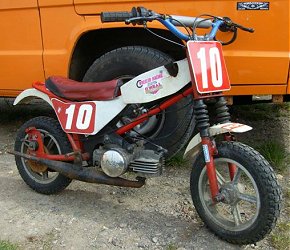

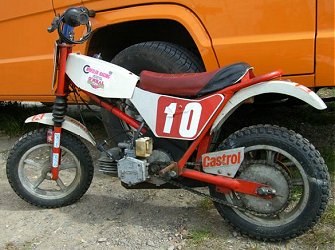
I've enclosed some pics, and was hoping you would be able to give me some history, etc?
Thanks,
Ben Charlton.
As Ben says, it is interesting. This is unlike any SIM50 we know about but it does have many SIM parts. The wheels are SIM and, since they were cast exclusively for the SIM, that gives two possibilities. Either this was made using parts salvaged from a 'Mark 4' SIM or it's a previously undocumented variant of the SIM50. A close look at the details, like the brake mounting, leads us to the conclusion that this is not a rebuilt Mark 4 - it looks as if the SIM story isn't finished yet.
[Letter published in Iceni CAM Magazine 16, January 2011. Photos © 2010 B Charlton.]
Another magazine, and another crazy scramble to get it ready on time.
When we said previously that nothing was prepared for the next edition, we really weren't joking!
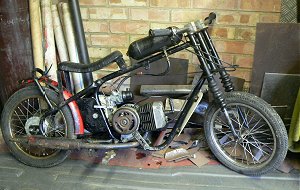
Mark 2 SIM50 before restoration
From a preparatory first interview with Peter Cornish that took place in 2008, there was barely more than a handful of notes that went off to Cyprus with Danny in the last week of July 2009, and came back just a week later as the beginnings of a starting draft called Round in Circles. These draft notes were worked into a text file over the following couple of weeks, while the four SIM 50s bounced in and out for photoshoots and test runs.

Newly restored Mark 2 SIM50
Paul Hunt proved the key connection that made presentation of our SIM feature a real prospect. His contributions were undoubtedly the breakthrough needed to make the production possible. Paul provided the original photograph of himself riding the very first SIM, granted full access to his own Mk1 SIM, originally supplied both the Mk2 and Mk3 SIMs that were restored to finally appear in the feature, was the source for many of the notes, and crucially, it was Paul who came up with the contact to Peter Cornish that made the whole feature project a reality.
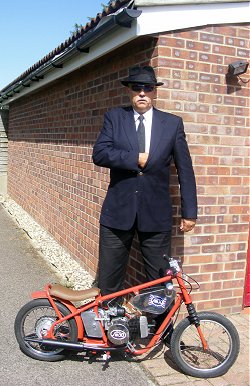
Bob towers over the Mark 2 SIM50
The Mk3 SIM came thanks to Paul Nelmes, who bought and rebuilt it for no other purpose than production of the article, and Chris Day for access to his Mk4.
Errol Bristow was another helpful contact, contributing further useful information, and important samples for pattern from his own Mk2 that he bought new for his son to ride back in the mid '70s. Since a full set of machines was required for the feature, IceniCAM's own Mk2 SIM was completely reconstructed from a pile of junk in just three days, including making a complete stainless steel petrol tank and mag cover, and a motor rebuild. Though undoubtedly 'over restored', it certainly looked great for the photoshoots, the first of which started only 2 days after completion! With SIM machines photographed on their own, (especially with IcenCAM's favoured style of low-angle photography), it's difficult to grasp much scale of how small these bikes actually are, standing just 28" to the highest point on the handlebars of a Mk2, and the saddle less than knee height to an adult. To give the SIM contrasting scale 'Big' Bob Vince certainly looked the part as 'The Management' for the first photoshoot on 1st August, followed by a second separate shoot for the Mk2, a third shoot for the Mk1 in the playground, a fourth shoot for the Mk4 on the green, a fifth shoot for the Mk3 on the table, then a sixth group shoot for all four bikes together.
Complicating matters further, the Mk4 is on permanent display at Ipswich Transport Museum. The museum is open every day over the summer season and didn't want to be without its SIM exhibit; that meant we had to temporarily 'swap' the Mk2 onto their stand to release the Mk4 for the feature.
All four bikes were run and paced since nobody had previously established what a SIM would actually do. The results were quite surprising in the speeds the Mk1, 2 & 3 achieved, proving fairly comparable with an Ariel 3, and probably rather faster than any of us might have expected for a children's bike with an adult aboard!
A second interview with Peter Cornish on August 18th 2009 allowed a review of the text to satisfy the contents, then working toward final draft for editing on 1st September. We're pretty confident this will now establish a reference article on SIM that is highly unlikely to ever be eclipsed, so there's a feeling of achieving something fairly worthwhile with this publication.
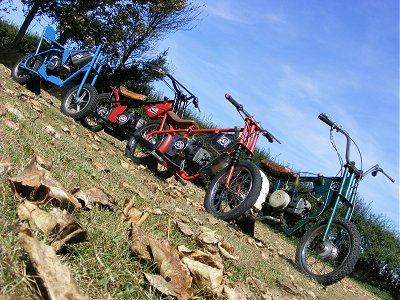
All four SIM50s
The ITM also ran a two-part version of the SIM article in the December 2009 and February 2010 Priory Press magazines, and have accepted the Mark 2 SIM, which is now on exhibition at the museum.
Though all pictures were taken in digital, which helped keep costs down, production involved a lot of running Round in Circles, and burnt up nearly £50 of fuel in the process. Many thanks to Peter Vaughan for sponsoring the article.